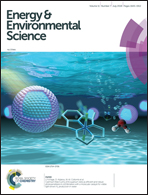Interfacial benzenethiol modification facilitates charge transfer and improves stability of cm-sized metal halide perovskite solar cells with up to 20% efficiency†
Abstract
Metal halide perovskite solar cells (PSC) exhibit outstanding power conversion efficiencies when fabricated as mm-sized devices, but creation of high-performing large-area PSCs that are stable under operating conditions on a sufficiently long timescale still presents a significant challenge. We demonstrate herein that modification of the interface between the perovskite and a spiro-OMeTAD hole-transporting material with commercially available para-substituted benzenethiol molecules facilitates fabrication of cm-sized PSCs with both improved efficiency and stability. Comprehensive analysis using specialised and conventional physical characterisation techniques has been undertaken to demonstrate that band alignment at the perovskite surface can be tuned to improve the solar cell efficiency via adsorption of benzenethiols with a significant dipole moment. Moreover, modification of the perovskite with cyano-substituted benzenethiol enhances charge extraction and reduces charge recombination in the devices. These effects enable improvements in the power conversion efficiency of PSCs from 19.0 to 20.2% and from 18.5 to 19.6% under 1 sun AM 1.5G irradiation with 0.16 and 1.00 cm2 apertures, respectively. Most importantly, benzenethiol-modified perovskite solar cells retain more than 80% of the initial performance after 185 h of continuous operation at 50% relative humidity and 50 °C device temperature under 1 sun irradiation, while devices with no interfacial modification undergo continuous deterioration down to 35% of the initial efficiency. These significant improvements are provided by a very simple and highly reproducibile modification procedure that can be readily adopted in other types of PSCs.



 Please wait while we load your content...
Please wait while we load your content...